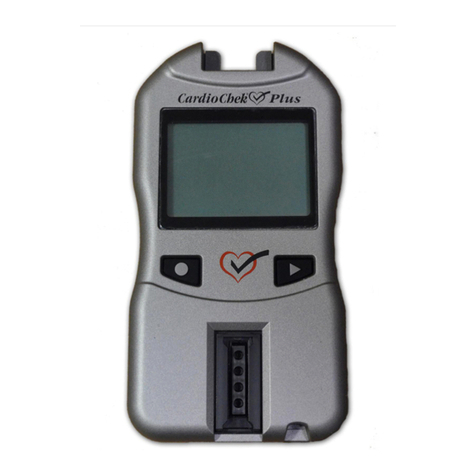@healthdiags
www.healthdiagnostics.co.uk
Conducting a TC/HDL/Glucose test
When conducting a combined TC/HDL/Glucose test you must not use the first droplet of
blood. Wipe the first droplet of blood away with a cotton swab or tissue. Gently massage the
finger to obtain the second droplet of blood, sufficient to fill a 40µL pipette. You must not press
around the puncture wound as this will alter the composition of the sample.
• Ensure you have the Orange memo chip in the machine and
Orange & Black test strip is inserted in the unit.
• Use a new disposable lancet to puncture skin (see finger stick
technique fact sheet for full instructions on how to obtain a blood
sample).
• Gently massage the finger and ensure you get a large droplet of blood before
drawing the blood into the pipette/tube.
• Place the 40µL pipette/tube into the droplet and fill to the line. The blood is drawn up
automatically by capillary action. Fill quickly, without air pockets.
• To express the blood out of the pipette/tube, squeeze the bulb on the plastic
capillary pipette or push the black plunger down if using glass tubes with plungers,
ensuring all of the blood is pipetted onto the strip.
• Press the button to RUN THE TEST. The test takes approximately 2½ minutes and
then the results are displayed.
Once the test has completed the machine will beep. The results will appear in the
following order, Total Cholesterol, HDL Cholesterol, Glucose, and finally the TC/HDL Ratio.
To scroll through results press the button, making a note of each result as it appears.
REMEMBER...
• CONDUCT AN OPTICS CHECK AT THE BEGINNING OF EACH DAY BEFORE USING THE ANALYSER.
• MAKE SURE YOU HAVE THE CORRECT STRIP.
• DON’TFORGET TO WIPE AWAY THE FIRST DROPLET OF BLOOD.
• WAIT FOR THE NEXT DROPLET TO FORM BEFORE PIPETTING -YOU WANT TO FILL THE TUBE QUICKLY, NOT A
LITTLE AT ATIME, IN ORDER TO AVOID AIR POCKETS AND UNDER FILLING THE TUBE.
• IF YOU DON’TAPPLY ENOUGH BLOOD TO THE TEST STRIP THE TEST WILL BE VOID, SO IF YOU THINK YOU HAVE
NOT COLLECTED ENOUGH, BEFORE APPLYING TO THE TEST STRIP, WIPE THE WOUND AGAIN, TAKE ANEW
PIPETTE, AND TAKE ANEW SAMPLE.
Side 2 of 2




























